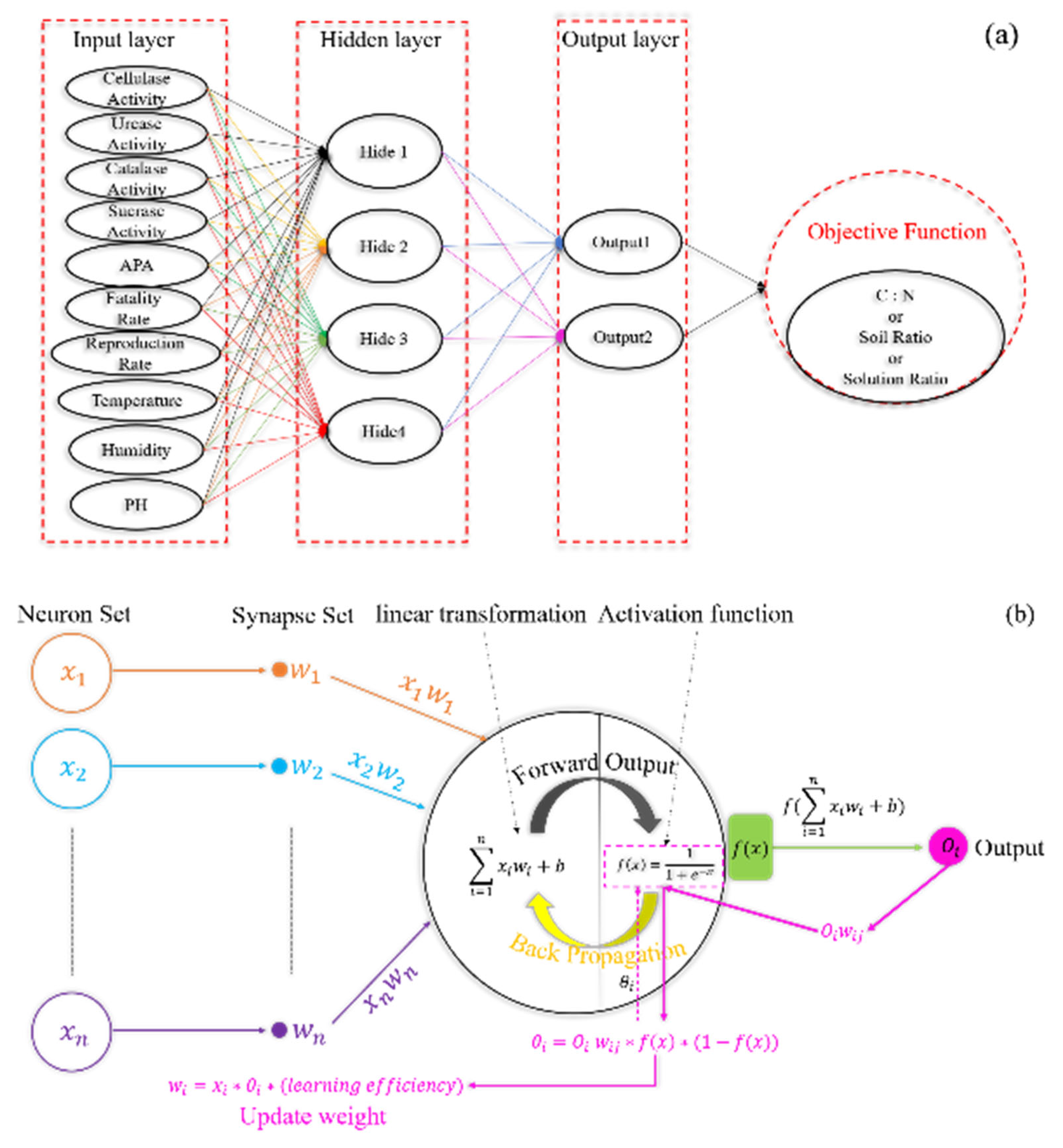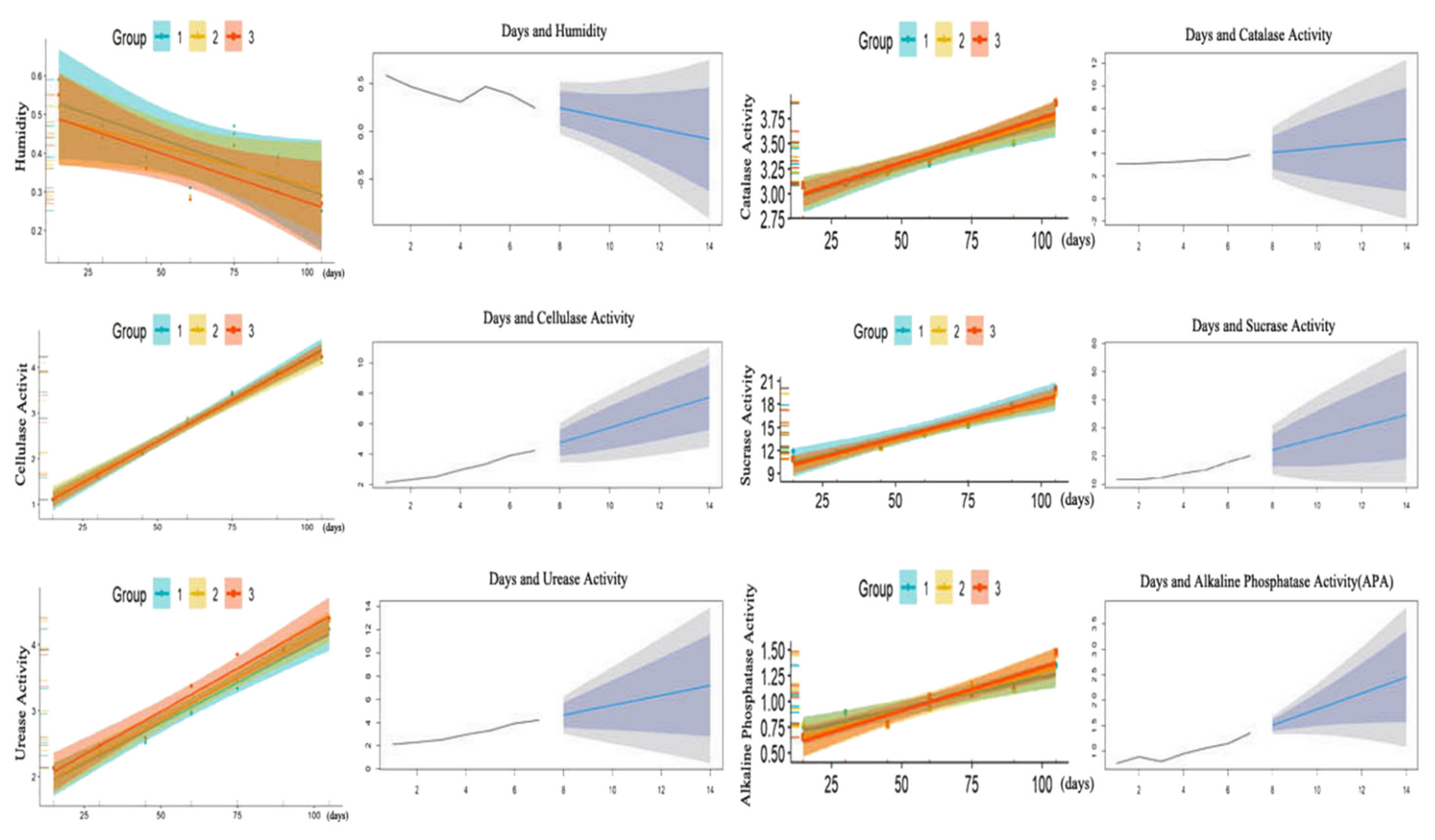Prediction of Salt-Tolerant Earthworms’ Cultivation Conditions Based on the Robust Artificial Intelligence Model
Abstract
:1. Introduction
2. Materials and Methods
2.1. Preparation of Experimental Materials
2.2. Simulation Experiment
2.3. Determination Method and Instrument
2.4. Mathematical Statistical Methods
2.5. BP Neural Network Algorithm
2.6. Statistical Analysis and Software Selection
3. Results and Discussion
3.1. Scheme Combination
3.2. Determination of C:N Boundary Point
3.3. Determination of Nahco3: Na2co3 Boundary Point
3.4. Base: Soil Determination of Boundary Points
4. Establish BP Prediction Model
4.1. Correlation Analysis
4.2. Initial Prediction Identification
5. BP Neural Network Model Establishment and Backtracking
5.1. Establish BP Neural Network Model
5.2. BP Neural Network Model Backtracking and Verification
6. Conclusions
Author Contributions
Funding
Data Availability Statement
Acknowledgments
Conflicts of Interest
References
- Wołejko, E.; Jabłońska-Trypuć, A.; Wydro, U.; Butarewicz, A.; Łozowicka, B. Soil biological activity as an indicator of soil pollution with pesticides—A review. Appl. Soil Ecol. 2019, 147, 103356. [Google Scholar] [CrossRef]
- Waigi, M.G.; Sun, K.; Gao, Y. Sphingomonads in Microbe-Assisted Phytoremediation: Tackling Soil Pollution. Trends Biotechnol. 2017, 35, 883–899. [Google Scholar] [CrossRef] [PubMed]
- Tang, J.; Zhang, J.; Ren, L.; Zhou, Y.; Gao, J.; Luo, L.; Yang, Y.; Peng, Q.; Huang, H.; Chen, A. Diagnosis of soil contamination using microbiological indices: A review on heavy metal pollution. J. Environ. Manag. 2019, 242, 121–130. [Google Scholar] [CrossRef] [PubMed]
- Nagajyoti, P.C.; Lee, K.D.; Sreekanth, T.V.M. Heavy metals, occurrence and toxicity for plants: A review. Environ. Chem. Lett. 2010, 8, 199–216. [Google Scholar] [CrossRef]
- Quina, A.S.; Durão, A.F.; Muñoz-Muñoz, F.; Ventura, J.; Mathias, M.D.L. Population effects of heavy metal pollution in wild Algerian mice (Mus spretus). Ecotoxicol. Environ. Saf. 2019, 171, 414–424. [Google Scholar] [CrossRef] [PubMed]
- Michaux, J.; Chevret, P.; Renaud, S. Morphological diversity of Old World rats and mice (Rodentia, Muridae) mandible in relation with phylogeny and adaptation. J. Zoöl. Syst. Evol. Res. 2007, 45, 263–279. [Google Scholar] [CrossRef]
- Negm, H.; Younes, N.; Rabee, A.; Youssef, M. Variations in growth behavior, yield and DNA stability of two vegetable crops cultivated in radioactive spiked soils. Environ. Pollut. 2019, 259, 113891. [Google Scholar] [CrossRef] [PubMed]
- Zhao, W.; Zhou, Q.; Tian, Z.; Cui, Y.; Liang, Y.; Wang, H. Apply biochar to ameliorate soda saline-alkali land, improve soil function and increase corn nutrient availability in the Songnen Plain. Sci. Total Environ. 2020, 722, 137428. [Google Scholar] [CrossRef] [PubMed]
- Sahariah, B.; Goswami, L.; Kim, K.-H.; Bhattacharyya, P.; Bhattacharya, S.S. Metal remediation and biodegradation potential of earthworm species on municipal solid waste: A parallel analysis between Metaphire posthuma and Eisenia fetida. Bioresour. Technol. 2015, 180, 230–236. [Google Scholar] [CrossRef] [PubMed]
- Gautam, A.; Ray, A.; Mukherjee, S.; Das, S.; Pal, K.; Das, S.; Karmakar, P.; Ray, M.; Ray, S. Immunotoxicity of copper nanoparticle and copper sulfate in a common Indian earthworm. Ecotoxicol. Environ. Saf. 2018, 148, 620–631. [Google Scholar] [CrossRef] [PubMed]
- Köhlerová, P.; Beschin, A.; Šilerová, M.; De Baetselier, P.; Bilej, M. Effect of experimental microbial challenge on the expression of defense molecules in Eisenia foetida earthworm. Dev. Comp. Immunol. 2004, 28, 701–711. [Google Scholar] [CrossRef] [PubMed]
- Kumar, P.S.; Behera, H.; K, A.K.; Nayak, J.; Naik, B. Advancement from neural networks to deep learning in software effort estimation: Perspective of two decades. Comput. Sci. Rev. 2020, 38, 100288. [Google Scholar] [CrossRef]











| Horizontal Type | Neurons Number in Input Layer | Neurons Number in Hidden Layer | Neurons Number in Output Layer | Weight Numbers | Iteration Value (100 Times) | Prediction Accuracy | |
|---|---|---|---|---|---|---|---|
| Initial Iteration | Final Iteration | ||||||
| Solution Ratio | 11 | 15 | 1 | 196 | 43.471938 | 0.101370 | 100% |
| Soil Ratio | 10 | 15 | 1 | 181 | 39.436749 | 10.923491 | 98.21% |
| C:N | 10 | 5 | 1 | 61 | 37.792288 | 1.544886 | 100% |
| Days | Fatality | Reproductive | PH | Temperature | |
|---|---|---|---|---|---|
| Test Group 1 | 30 | 0.08 | 0.24 | 8.78 | 25 |
| Test Group 2 | 45 | 0.3 | 0.2 | 6 | 25 |
| Humidity | Cellulase | Urease | Catalase | Sucrase | |
| Test Group 1 | 0.48 | 2.52 | 2.004 | 2.841 | 14.28 |
| Test Group 2 | 0.45 | 2 | 0.8 | 1.5 | 12.28 |
Disclaimer/Publisher’s Note: The statements, opinions and data contained in all publications are solely those of the individual author(s) and contributor(s) and not of MDPI and/or the editor(s). MDPI and/or the editor(s) disclaim responsibility for any injury to people or property resulting from any ideas, methods, instructions or products referred to in the content. |
© 2023 by the authors. Licensee MDPI, Basel, Switzerland. This article is an open access article distributed under the terms and conditions of the Creative Commons Attribution (CC BY) license (https://creativecommons.org/licenses/by/4.0/).
Share and Cite
Wang, M.; Chu, S.; Wei, Q.; Tian, C.; Fang, Y.; Chen, G.; Zhang, S. Prediction of Salt-Tolerant Earthworms’ Cultivation Conditions Based on the Robust Artificial Intelligence Model. Sustainability 2023, 15, 6484. https://doi.org/10.3390/su15086484
Wang M, Chu S, Wei Q, Tian C, Fang Y, Chen G, Zhang S. Prediction of Salt-Tolerant Earthworms’ Cultivation Conditions Based on the Robust Artificial Intelligence Model. Sustainability. 2023; 15(8):6484. https://doi.org/10.3390/su15086484
Chicago/Turabian StyleWang, Mingyue, Shengzhe Chu, Qiang Wei, Chunjie Tian, Yi Fang, Guang Chen, and Sitong Zhang. 2023. "Prediction of Salt-Tolerant Earthworms’ Cultivation Conditions Based on the Robust Artificial Intelligence Model" Sustainability 15, no. 8: 6484. https://doi.org/10.3390/su15086484






